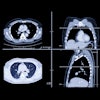
Overall cancer death rates continued to decline from 2010 to 2014, the latest period examined in the American Cancer Society's (ACS) annual report on cancer, the ACS said in a statement accompanying a report in the Journal of the National Cancer Institute.
From 2010 to 2014, the overall cancer death rate fell by 1.8% per year in men, 1.4% per year in women, and 1.6% per year in children. Cancer death rates decreased during the four-year period for 11 of the 16 most common types of cancer in men and for 13 of the 18 most common types of cancer in women, including lung, colorectal, female breast, and prostate cancers, the report stated (JNCI, March 31, 2017).
At the same time, death rates increased for cancers of the liver, pancreas, and brain in men, and they also rose for liver and uterine cancer in women. Cancer incidence rates, or rates of new cancers, fell among men but only stabilized in women during the period of 1999 to 2013.
The authors attributed the decline to improvements in early detection and treatment, as well as reductions in tobacco use. But some 40 million American adults still smoke, and smoking remains the leading cause of cancer death.
The report includes a special section that focuses this year on cancer survival, expressed as a percentage. This section showed that survival for several -- but not all -- cancer types improved significantly for both early- and late-stage disease, while varying significantly by race, ethnicity, and state.
"While trends in death rates are the most commonly used measure to assess progress against cancer, survival trends are also an important measure to evaluate progress in improvement of cancer outcomes," said the study's lead author, Ahmedin Jemal, PhD, from the ACS, in a statement.
Since the last time this type of information was included in 2004, survival has improved for almost all cancers at almost all stages of diagnosis. At the same time, survival remains very low for some types of cancer and for most cancers diagnosed at advanced stages, he added.
For example, five-year survival for cancers diagnosed in 2006-2012 increased significantly compared with the same cancer types in 1975-1977, except for cancers of the cervix and uterus. The single greatest increases in survival, 25% and higher, were seen in prostate and kidney cancers, as well as for non-Hodgkin's lymphoma, myeloma, and leukemia, according to the report.
| Cancer survival rates, 2006-2012 | |||||
| Cancers with highest survival rates | |||||
| Prostate | 99.3% | ||||
| Thyroid | 98.3% | ||||
| Melanoma | 93.2% | ||||
| Female breast | 90.8% | ||||
| Cancers with lowest survival rates | |||||
| Brain | 35% | ||||
| Stomach | 31.1% | ||||
| Esophagus | 20.5% | ||||
| Lung | 18.7% | ||||
| Liver | 18.1% | ||||
| Pancreas | 8.5% | ||||
Even though five-year survival rates improved for both whites and blacks for most cancer types, racial disparities for many common cancers have persisted -- and may have even increased -- for prostate cancer and female breast cancer.
More attention and resources are needed to identify important risk factors for common cancers, such as colorectal, breast, and prostate, and greater efforts are needed to understand the increasing incidence trends in uterine, female breast, and pancreatic cancers, the authors noted.



















